
Newsletters are everywhere. Whether it’s a round-up of weekly news, a podcast newsletter, or any other content, you usually know what’s inside. But, when it comes to ecommerce, newsletters look a little different. How do you make an ecommerce newsletter inform like a newsletter from a content site — while also selling to the reader?
Once you learn the strategies to do this, you’ll start to see them everywhere. The key is knowing your customer well. From there, toe the line between informational and sales-focused to create an engaging newsletter.
Below, we’ll go through what an ecommerce newsletter is, why it’s unique, and how to write interesting newsletters that sell. We’ll also throw in examples of ecommerce businesses that do a superb job with their newsletters.
What is an ecommerce newsletter?
An ecommerce newsletter is a form of content marketing that doesn’t have sales as its primary purpose. Newsletters are mainly a way to stay in touch with customers or potential leads — those considering buying from you.
Newsletters give readers added value without paying more money. Readers give you their attention and you give them information they want to know or find interesting.
For example, if you sell sponges, you could send newsletters that give cleaning tips. You can share third-party content or address any current events. Did the TV show Top Chef just have a season finale? Share how the crew cleans those kitchens until the equipment feels new again.
Newsletters are opportunities to connect with your readers beyond your product.
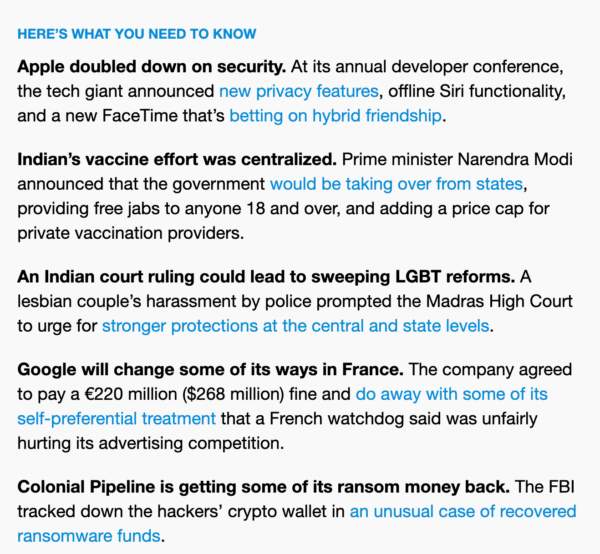
What makes ecommerce newsletters unique?
Any newsletter from a content site is full of information and links to their online content. They want you to read a snippet, find it interesting, and click through to their site. This improves their traffic. Ideally, you’ll enjoy and share it.
For ecommerce, that’s not the whole picture. Ecommerce newsletters are trying to inform and entertain while also bringing in sales. If you push the sales part too strongly, your readers will feel alienated and could unsubscribe. But if you focus only on content, your newsletters might never sell anything.
How can you turn newsletter readers into proud customers?
How do newsletters change the way leads and customers feel about you? These emails can do a lot. With engaging newsletters, you can:
- Give customers reasons to be proud of having your product
- Open opportunities to buy
- Show your leads how well-versed you are in industry topics
- Stand out among your competitors
How do you create a great ecommerce newsletter?
What if an ecommerce newsletter seems like a great content marketing opportunity but you don’t know where to start when it comes to creating one? Let’s go through the basics of what you need to know.
Start and grow an email list
Choose an email provider like Constant Contact and set up a sign-up page on your website. It can be a pop-up, a sidebar, or a footer. Next, grow your email list to get quality leads that are interested in what you offer. These will be both people who bought from you and those who might in the future.
Design your newsletter
You want to keep things short, scannable, and easy to digest. Clearly outlining what readers can expect to find will help. Content newsletters do this, too.
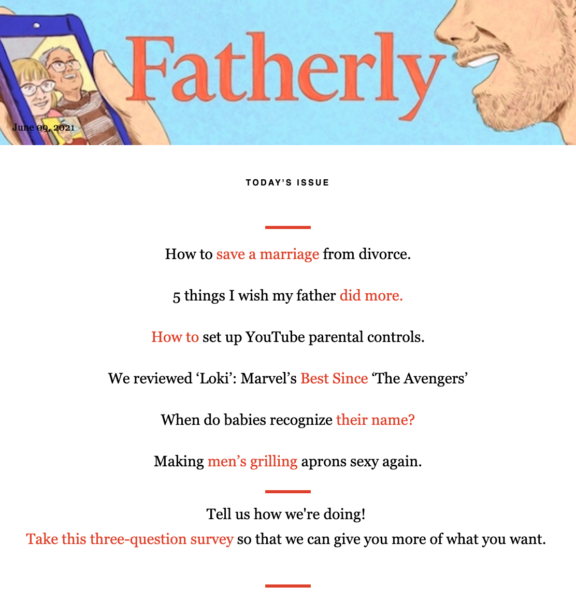
Create sections for what you want to share and include only short snippets. Add a link to the full article so your readers can learn more on your landing pages or blog posts. If you’re not sure exactly how to create your email, use an email template to get started.
Create your content
Think about your ideal customers and what they like. Use their tone, vocabulary, and interests as your guide. Write your content to make it feel like they’re coming back to a familiar newsletter every week.
Have a common style among your newsletters
If you’re the owner of this theoretical sponge business we mentioned, maybe your newsletters can tackle a new type of surface or stain every week. At the bottom, you can include a new fun fact about your sponges.
You can also use your newsletter to shed insights on industry trends, tell stories about your product, and share your company’s recent achievements. Don’t be afraid to connect with them as you would on a lunch outing with a friend.
Hone in on topics that will interest your reader
Here are some topics to include in your newsletters:
- Create surveys and ask for feedback
- Tease your new product launch
- Tell the story of a staff member or customer case study
- Share your expertise about relevant topics via blog posts
Try not to tackle them all — rather, hone in on what will speak to your reader the most and get feedback from your readers to learn more and get better at writing your email newsletters.
Balance your content and your “buy” buttons
One key to a well-performing ecommerce newsletter is striking a balance between piquing your reader’s interest and nudging them to buy. Remember that the primary goal of your newsletter isn’t to sell.
Carefully sprinkle in your creative calls to action (CTAs). These are requests for readers to do something, like buying a product. If you have a newsletter that takes four to five minutes to read, add three “buy” CTAs at most. You can place them at the top and bottom of your email. These CTAs should entice the reader to do the desired action. Use action words like “get limited offer” or “get relief now” — anything that speaks to your reader’s motivations.
The rest of your email should focus on their interests and benefits. Ask yourself these questions to know for sure that you’re offering great content:
- Does this content make them feel empowered or defeated?
- How will this information help my reader?
- Which problem does this content solve?
- Would they share this with a friend or loved one?
What are some excellent ecommerce newsletter examples?
Let’s go through some examples of companies that nail their ecommerce newsletters.
My Fitness Pal (Under Armour)
Under Armour uses their app — My Fitness Pal — as a content marketing platform and as a product. The free version offers things like calorie tracking but you can subscribe to a paid version of the app for more. The My Fitness Pal newsletter focuses on questions that users of the app might have.
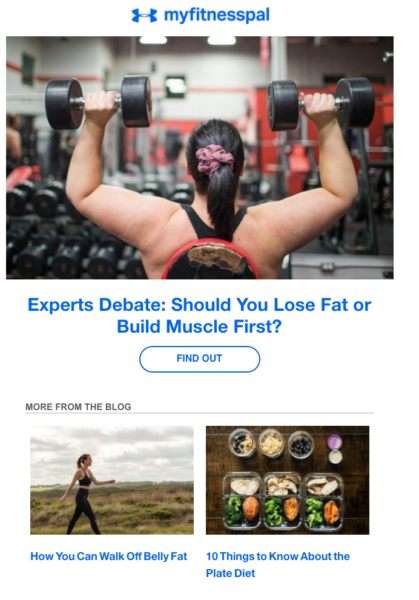
Under Armour is already seen as knowledgeable about fitness but they used a My Fitness Pal newsletter for an expert debate. The topic is a very common one in the fitness space: “Should I lose fat or build muscle?” It’s engaging and makes readers want to learn more — and continues to place Under Armour as an industry expert.
Skillshare
Skillshare offers creative online courses. Their newsletters are always inspiring, making readers feel like they’re creators. Take the Skillshare newsletter below, for example, which draws the reader to engage fully in a quiz.
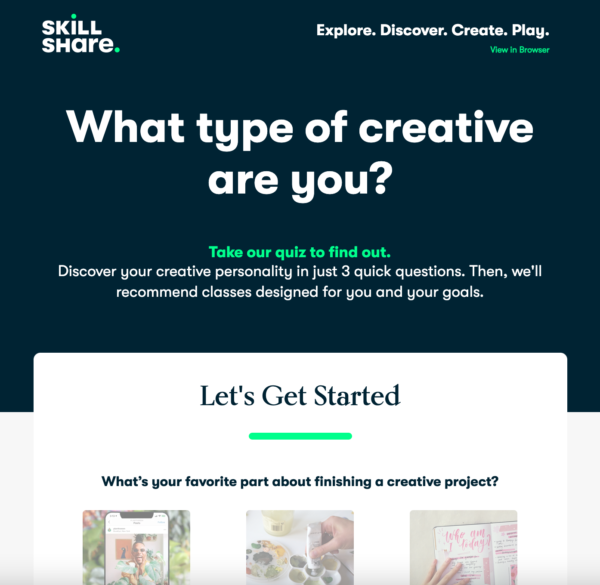
After you click through the answers that speak to you in the Skillshare quiz, there’s a call to action that takes you to a landing page. There, you’ll not only see what kind of creative you are but also all the courses they offer that are perfect for you.
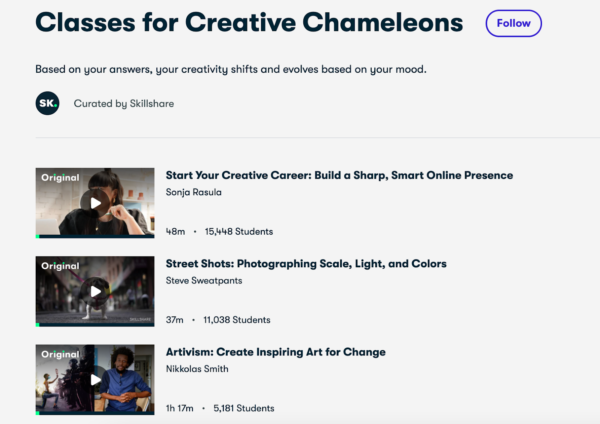
If you don’t have a premium account with Skillshare, you’ll certainly feel called to buy a course or sign up for a paid membership. Quiz content is just one of the many creative ideas for newsletters that can make your sales messaging feel more user-centric and benefit-focused. This reminds readers why they’re subscribed in the first place.
Trello
The example from Trello below uses fragments of their blog content in their newsletter, with invites for readers to read further on the topics on their website.

As readers scroll and look for a headline that calls out to them, Trello drops some news about new features — and adds that readers can try these features for free. Their newsletter readers are most likely using Trello already, so new features should make their experience better. That subtle call to action can easily turn into a sale once that free trial ends.
If the reader enjoys the free trial, they’ll usually have no problem continuing to pay for it. Don’t underestimate the power of free samples paired with a good newsletter CTA.
How should you kick off your ecommerce newsletter?
Ecommerce newsletters each have their own style. Many companies have more than one to keep all types of users engaged with their brand. But you only have to start with one newsletter — and now that you know what an ecommerce newsletter is and how to create one, you can start turning leads into customers.
Ready to give it a try? Start your email marketing journey with an ecommerce newsletter of your own.




